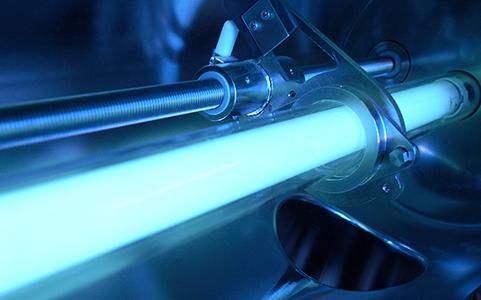Germicidal Action of UV Light

Ultraviolet (UV) is that part of electromagnetic light bounded by the lower wavelength extreme of the visible spectrum and the X-ray radiation band.
The spectral range of UV light is, by definition between 100 and 400 nm (1 nm=10-9m) and is invisible to human eyes. Using the CIE classification the UV spectrum is subdivided into three bands:
- UVA (long-wave) from 315 to 400 nm
- UVB (medium-wave) from 280 to 315 nm
- UVC (short-wave) from 100 to 280 nm
In reality many photobiologists often speak of skin effects from the weighted effect of wavelength above and below 320 nm, hence offering an alternative definition.
A strong germicidal effect is provided by the Light in the short-wave UVC band. In addition erythema (reddening of the skin) and conjunctivitis (inflammation of the mucous membranes of the eye) can, also be caused by this form of Light. Because of this, when germicidal UV-Light lamps are used, it is important to design systems to exclude UVC leakage and so avoid these effects.
Germicidal action
The UV light emitted by a source is expressed in watts (W) and the irradiation density is expressed in watts per square meter (W/m2). For germicidal action dose is important. The dose is the irradiation density multiplied by the time (t) in seconds and expressed in joules per square meter (J/m2). (1 joule is 1W.second).
From figure 10 it can be seen that germicidal action is maximised at 265 nm with reductions on either side. Low pressure lamps have their main emission at 254 nm where the action on DNA is 85% of the peak value and 80% on the IES curve. For wavelengths below 235 nm the germicidal action is not specified, but it is reasonable to assume that it follows the DNA absorption curve.
Micro-organisms effective resistance to UV light varies considerably. Moreover, the environment of the particular micro-organism greatly influences the radiation dose needed for its destruction. Water, for instance, may absorb a part of the effective radiation depending on the concentration of contaminants in it. Iron salts in solution ware well known inhibitors. Iron ions absorb the UV light. The survival of micro-organisms when exposed to UV light is given by the approximation:
Nt/N0 = exp. (-kEeff t) ...................1
Hence ln Nt/N0 = -kEeff t ................2
- Nt is the number of germs at time t
- N0 is the number of germs before exposure
- k is a rate constant depending on the species
- Eeff is the effective irradiance in W/m2
- The product Eefft is called the effective dose
- Heff and is expressed in W.s/m2 of J/m2
It follows that for 90% kill equation 2 becomes
2.303 = kHeff
Some k value indications are given in table 2, where they can be seen to vary from 0.2 m2/J viruses and bacteria, to 2.10-3 for mould spores and 8.10-4 for algae.
